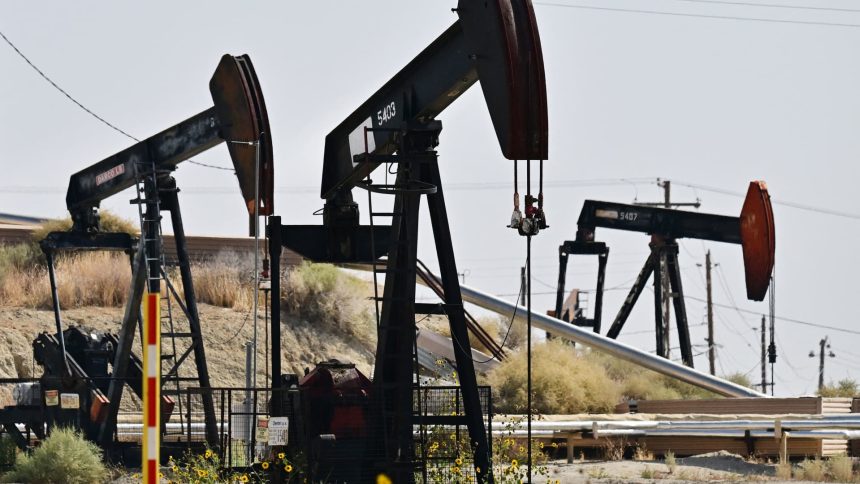U.S. oil prices have climbed to their highest level since late October, as the rally in the key commodity becomes something equity investors cannot afford to look past. West Texas Intermediate crude futures rose modestly Wednesday and at one point breached $86 a barrel, bringing the U.S. oil benchmark’s year-to-date gain to 19%. Brent crude also climbed Wednesday and nearly eclipsed $90 a barrel. The global oil standard is up about 16% in 2024. Meanwhile, shares of Coterra Energy , our lone oil-and-gas holding, are up about 9% over the past month, among the top-performing portfolio stocks in that timeframe. Energy has been by far the best S & P 500 sector during the same stretch, jumping more than 12% compared with a roughly 1.7% gain for the index. The latest news driving Wednesday’s gains for oil: The Organization of Petroleum Exporting Countries and a group of partner producers led by Russia, together known as OPEC+, does not plan to change its output policy . OPEC+ last month agreed to extend its 2.2 million barrels per day output reduction until the end of the second quarter in an effort to support prices. Outside of the cartel’s policy, the multiweek rally for crude has been driven by positive demand updates and concerns about supply amid mounting tensions in the Middle East. The much-better-than-expected ISM Manufacturing PMI reading released Monday — 50.3 versus 48.1 expected — was a significant development for the oil market for multiple reasons. Not only was it stronger than anticipated, but it was on the right side of 50, indicating that U.S. manufacturing activity expanded for the first time since September 2022. Moreover, in a commentary section of the ISM report, many respondents indicated they expected to see activity pick up into the back half of the year. In other words, the latest ISM Manufacturing report serves to support the view that the U.S. economy is doing much better than many believed it would just a few months ago. A separate report this week also painted a positive picture about manufacturing activity and business confidence in China, the world’s second-largest economy and a huge buyer of oil. The supply side of the oil equation is being challenged by more than just OPEC+. The ongoing war between Russia, a major oil producer, and Ukraine remains a risk; on Tuesday, Ukrainian drone strikes hit a Russian oil refinery , though Reuters reported that damage to the facility is not significant, citing an unnamed industry source. There also is added geopolitical risk premium resulting from Israel’s decision to strike part of an Iranian embassy complex in Syria — a move that Iran, a top 10 global oil producer, has vowed to respond to . Oil trading at its highest levels since late October has implications for stock market investors. As Jim Cramer said during Wednesday’s Morning Meeting, we can’t have our head in the sand about the climb in crude. For starters, it means the Federal Reserve is right to keep rates where they are. If energy prices remain around these levels, or go even higher, that’s an elevated input cost for companies that serves to pressure profit margins. If companies can’t mitigate the cost of energy through cost cuts elsewhere, they may look to raise prices on their products. That is exactly what the Fed does not want to see. Indeed, “oil is fighting the Fed, again,” Bank of America commodities strategists wrote in a note to clients Wednesday. We also need to monitor employment trends and wage inflation that much more closely. The Fed’s preferred measure of inflation may be the core personal consumption expenditures price index, which removes the impact of food and energy prices, but consumers still pay for energy. It’s a very material, largely unavoidable cost, especially as the weather warms and we get into the summer driving months. The rise in energy prices — particularly at the gas pump — can result in a decrease of discretionary dollars left for other purchases. Fortunately, in a sign of labor market strength, the ADP’s private payroll report for the month of March came in stronger than expected Wednesday, with wages up 5.1% for workers who stayed in their jobs. The next big watch item on this front will be Friday’s March nonfarm payroll report. For now, the bottom line is the increase in oil prices is not great from a cost perspective for corporations or consumers — but the negative must also be balanced out by the fact that economic strength is one factor driving the rise. U.S. unemployment remains low and wages are now rising faster than inflation. With first-quarter earnings season kicking off in earnest next week with bank reports and ramping up from there, we’ll be listening closely to see how companies are feeling and responding to the increase in energy prices. (Jim Cramer’s Charitable Trust is long CTRA. See here for a full list of the stocks.) As a subscriber to the CNBC Investing Club with Jim Cramer, you will receive a trade alert before Jim makes a trade. Jim waits 45 minutes after sending a trade alert before buying or selling a stock in his charitable trust’s portfolio. If Jim has talked about a stock on CNBC TV, he waits 72 hours after issuing the trade alert before executing the trade. THE ABOVE INVESTING CLUB INFORMATION IS SUBJECT TO OUR TERMS AND CONDITIONS AND PRIVACY POLICY , TOGETHER WITH OUR DISCLAIMER . NO FIDUCIARY OBLIGATION OR DUTY EXISTS, OR IS CREATED, BY VIRTUE OF YOUR RECEIPT OF ANY INFORMATION PROVIDED IN CONNECTION WITH THE INVESTING CLUB. NO SPECIFIC OUTCOME OR PROFIT IS GUARANTEED.
U.S. oil prices have climbed to their highest level since late October, as the rally in the key commodity becomes something equity investors cannot afford to look past.
Read the full article here
News Room




